It's the time of year when I report on my book sales and reflect on what I could do better! I hope you find this article useful for your own author business, whatever stage you're at.
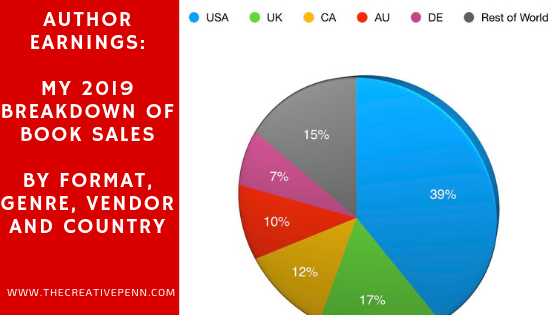
My company tax year runs May – April and although I keep a tight rein on my income, expenses and cash flow throughout the year, I only do management reporting annually when I break down my revenue in various ways to figure out what I need to change, stop doing or do more of.
These figures are all based on revenue, the money that has actually come into my bank account, not sales volume (i.e. number of books sold).
Because I publish through so many sources, I don't actually track book sales numbers and have definitely lost track at this point. Let's be honest – the money is more important anyway!
You can always see my previous years' breakdown at TheCreativePenn.com/timeline along with other significant articles from my author-entrepreneur journey. Click here for 2018 book sales income breakdown specifically.
[Thanks to Russell Philips, Virtual Assistant at Author Help who collated all my figures from all the various platforms.]
Total Income Breakdown
I've been running this business since 2008 and my revenue split has changed over the years, but it is all based on my writing.
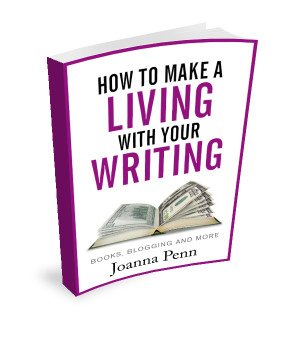
My total business income is down by 5% this year. That's not really a significant amount but still a downward trend despite publishing more books and continuing to publish 3x a week on this site. Hence my focus on changing things up over the next 10 years (see my big AI disruption post here).
My book sales income is slightly up, and although ebook revenue is down, it is more than made up for by audiobook and print sales.
My book sales income alone is around about 2.5x the UK national average salary and 7x the average author income reported in the recent All Party Writer's Group report.
Remember, I have never had a breakout success, I've never been stocked in high street bookstores or had a supermarket deal. I've made a living with my writing since 2011 as an independent author entrepreneur and continue to subscribe to the consistent hard-working author model! You don't need to be a household name to make a decent living with your writing.
Of course, I make less than some authors I know – some indie, some traditionally published. But comparisonitis is dangerous, and instead, we should be comparing our current selves against where we were last year, and where we want to be next year. Here's my detailed breakdown.
Book Sales Revenue by Format
My audiobook revenue has almost doubled again this year (8% in 2018, now 15%) as well as print sales being slightly up (21% in 2018).
I am not in KU, so this is wide ebook income and I am thrilled that my focus on wide distribution for the other channels has resulted in a higher percentage of other format sales. Next year, I'll break it down by paperback, hardback and Large Print as well to give those formats a full year of sales.
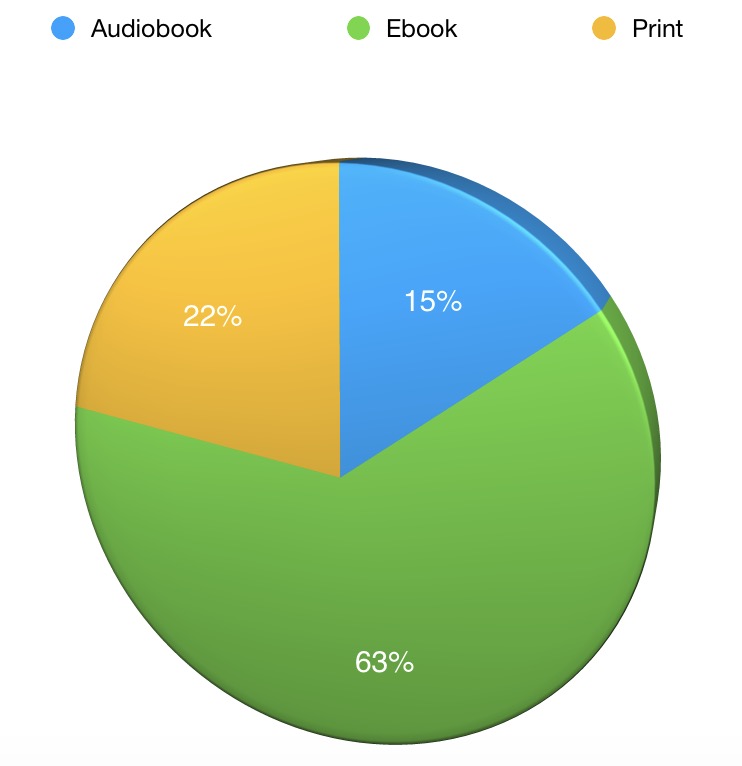
Book Sales by Vendor
Even though I publish wide, it's not surprising that Amazon continues to be the largest share of revenue given their dominance in the English speaking markets.
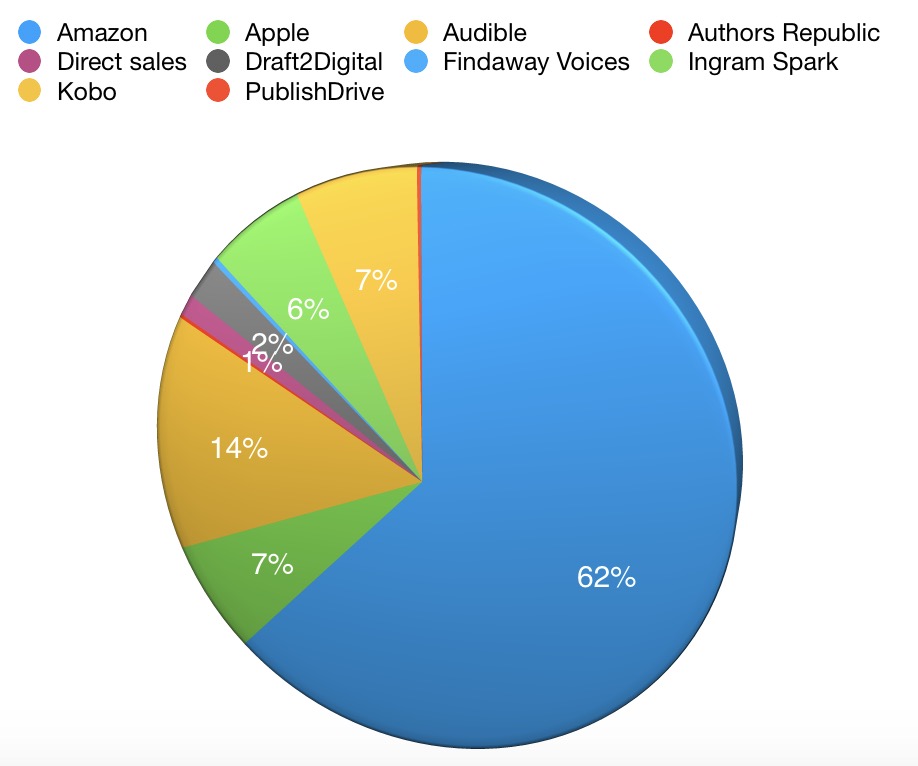
My advertising costs are actually down on last year and that may account for book sales staying much the same even though I have more books out.
20% of my book sales income was spent on advertising, which includes BookBub, Amazon Advertising, Written Word Media and some other things like Facebook Ads, although most of my Facebook spend was for affiliate promotions. I'll be investing more in ads this year.
Revenue by Fiction / Non-Fiction
Currently, I have 10 non-fiction books (2 of which are co-written), and 20 fiction books (not including box-sets, 5 co-written). But as you can see, non-fiction brings in more income.
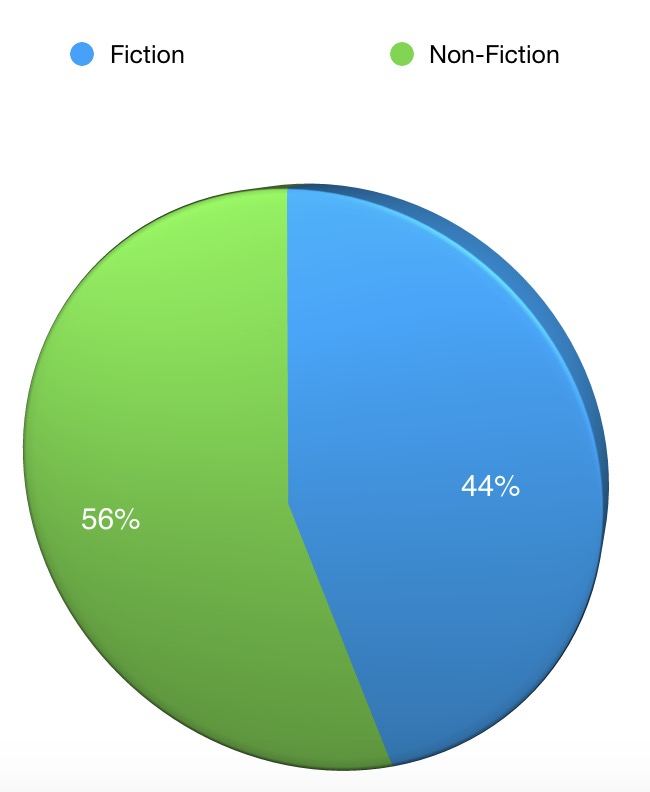
There are several reasons for this — and of course, this is all anecdotal based on my book sales. Every author will be different.
- I have a much more developed marketing platform for my non-fiction with this site and my podcast. I hope to replicate this with Books And Travel over the next few years but Content Marketing for Fiction is a long game.
- The rise in print sales and audiobooks are mostly for non-fiction, as per the breakdown below. Non-fiction readers are less price sensitive and may buy in multiple editions e.g. audiobook and then print for reference.
- I write thrillers and dark fantasy and many genre fiction authors are doing well in KU + a lot of paid ads, which is not my business model. [See my reasons for wide publishing here.] I have not done much marketing of my fiction books on other platforms in the last year. I should be doing more BookBub and Facebook in terms of advertising for the other platforms, but I tend to focus on other things like creating more, as that is what I enjoy 🙂
- Fiction sales go up and down but the books are long term earners (as long as you retain the rights). They don't go out of date, unlike non-fiction, which you often have to rewrite. Fiction is a long-term career and over the long-term, I expect those books to earn more, but short-term income is clearly easier with non-fiction.
- Paid ads which are easier to target with non-fiction keywords and there is less competition for bids so the clicks are cheaper (at least at the moment!)
You can see the variability by store in the figure below. Clearly, my audio sales are primarily non-fiction, as well as my print sales through Ingram. My direct sales using Payhip are also primarily non-fiction, because of the traffic to this website and the size of my audience after 10+ years in this niche.
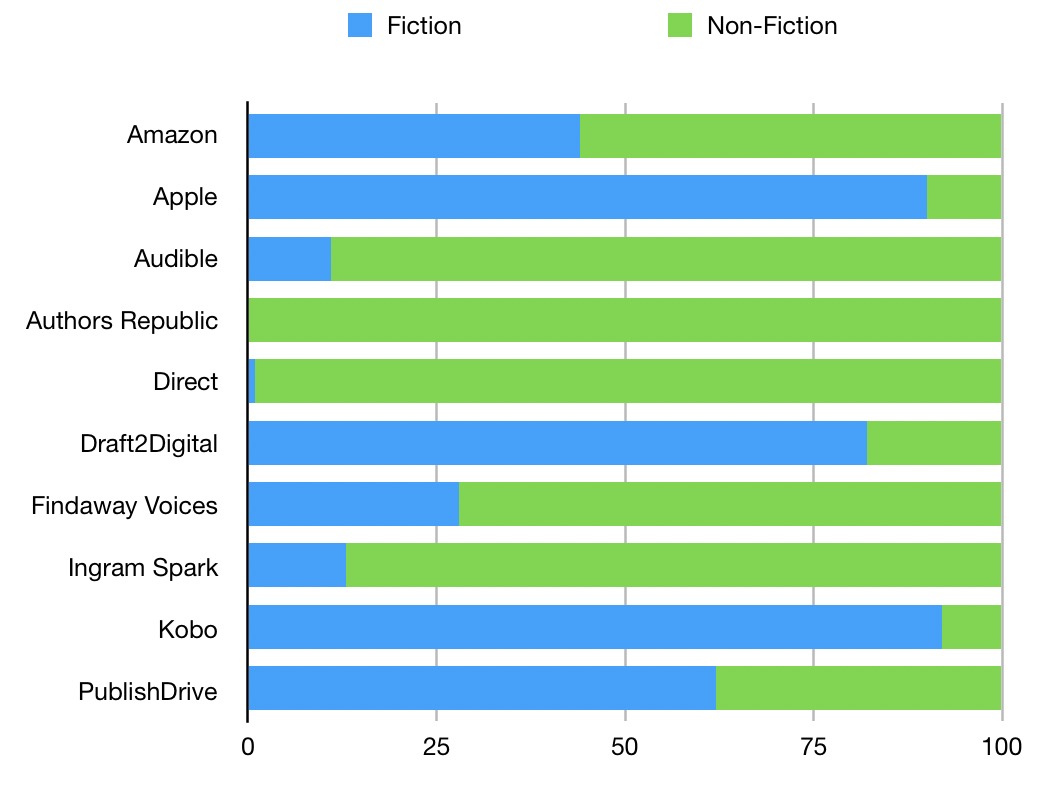
Book Sales Revenue by Country
I have sold books in 54 countries this year (in English) which I am thrilled about 🙂 That doesn't include free downloads which have reached even further.
I love being an international author! Owning your global rights is a secret weapon as you can take every opportunity to reach more readers. Sometimes I feel like this is the most significant difference between me and my traditionally published author friends, who are usually only concerned with one territory e.g. UK if they are British, or US if they are American. But as indie authors, it's possible to sell in 190 countries so we can focus on international sales in multiple formats.
This country split has changed quite significantly in the last year, as I suggested it would as digital sales start to spread.
I've included last years image as a comparison so you can see how much smaller the US sales are as a percentage of the whole and how much the Rest of World segment has grown. I think this will continue to accelerate with the spread of 4G and 5G internet to another 4 billion people by 2025. If you want to reach a global market, check out my episode on publishing wide and the free ebook on Successful Self-Publishing.
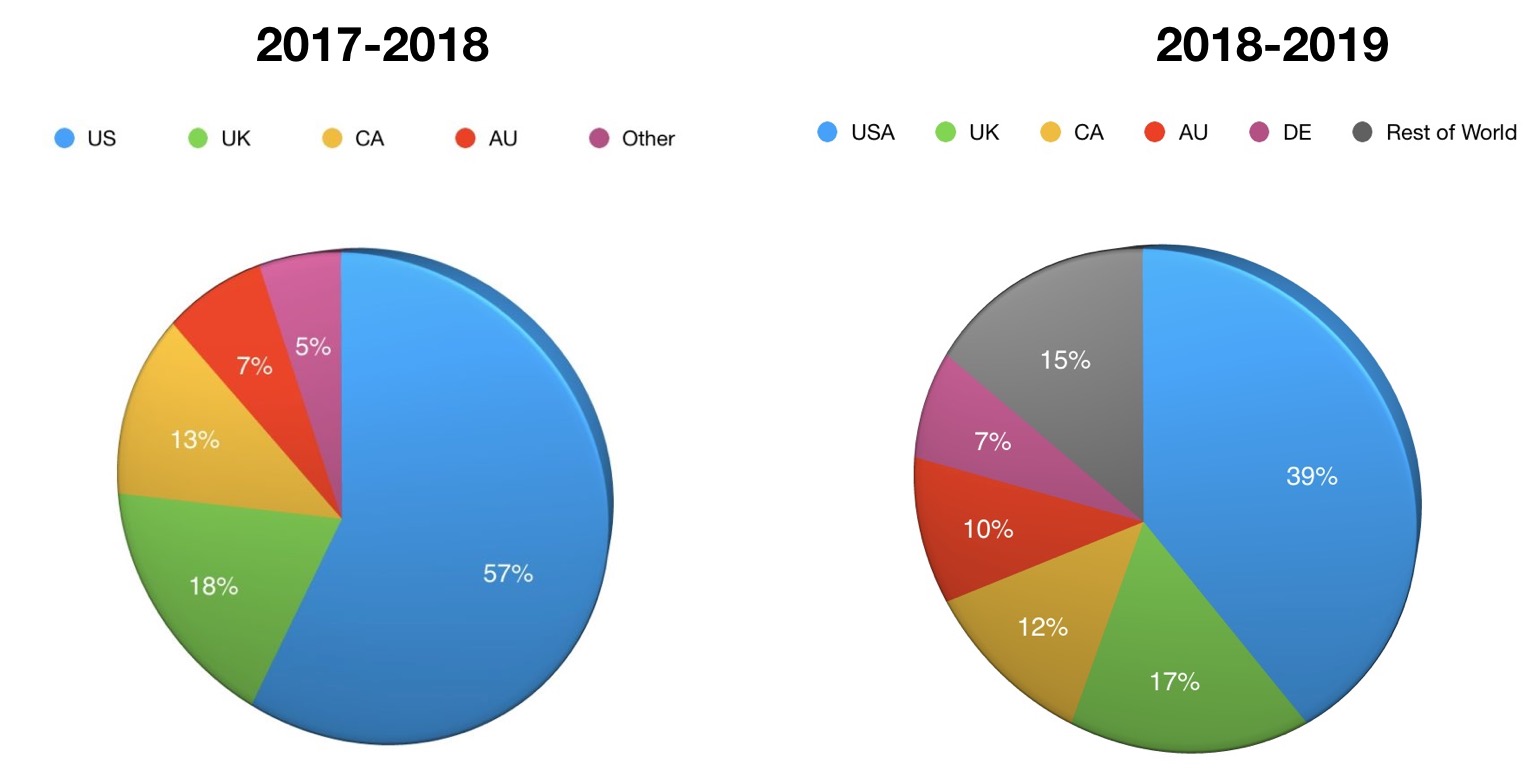
Australian sales have grown and so have German sales, even though my books are in English. Rest of the World has grown from 5% to 15% of revenue. This encourages me to focus more on my international growth as it really amplifies the multiple streams of income effect.
What am I going to focus on in the next year?
As I stated in my 2019 goals, I am focusing on being a better publisher. That means getting all my backlist into the formats that sell. More print. More audio. I am also going to investigate some of the AI-assisted translation services becoming available, although I expect that to grow further in 2020 onwards.
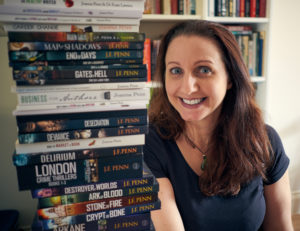
I did think I would write more fiction this year, but I am too much of a polymath to focus on one genre, so I will continue to write and publish the books I want when the Muse strikes me. I have a list for the rest of the year, so will just keep on keeping on. I love my work and I don't want to put pressure on my creativity.
I will never be a high-volume writer in one targeted genre. I will never write to market. I will never be an expert in paid ads. And that's OK! We are all different and indie is a broad church with many routes to becoming an author-entrepreneur. You get to choose your path and no way is better than any other.
I will continue to focus on global sales, and I'm excited about Google adding a Podcast app and also putting podcasts into search since my podcast has been downloaded in 215 countries, and has definitely driven book sales across the globe. I hope the same will happen with my fiction now I have started the Books and Travel Podcast as well. Exciting times!
So that's my round-up. Have you reported on your annual sales revenue and broken it down this way? Please do share in the comments if you have anything, or ask any questions you'd like answered.
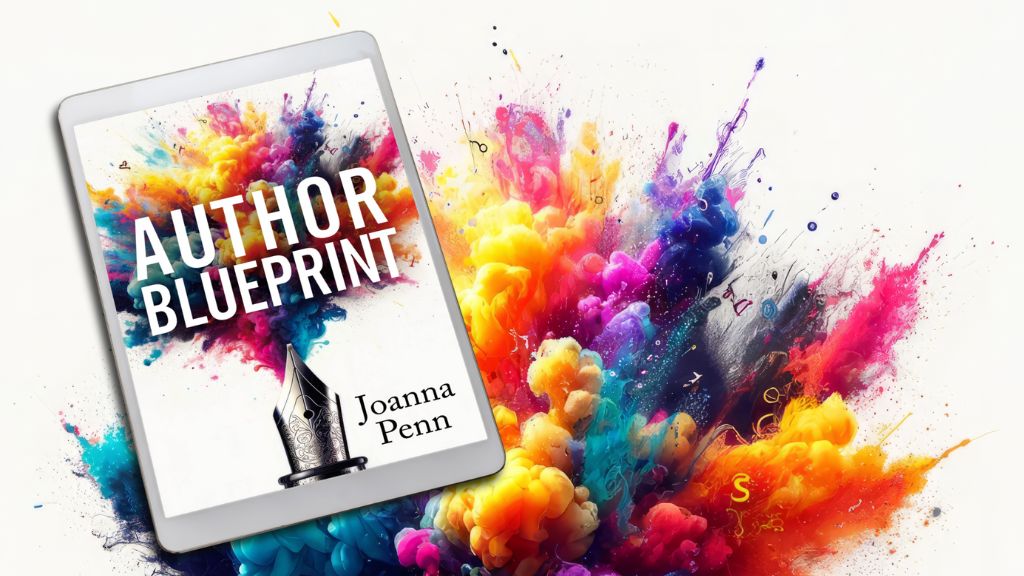
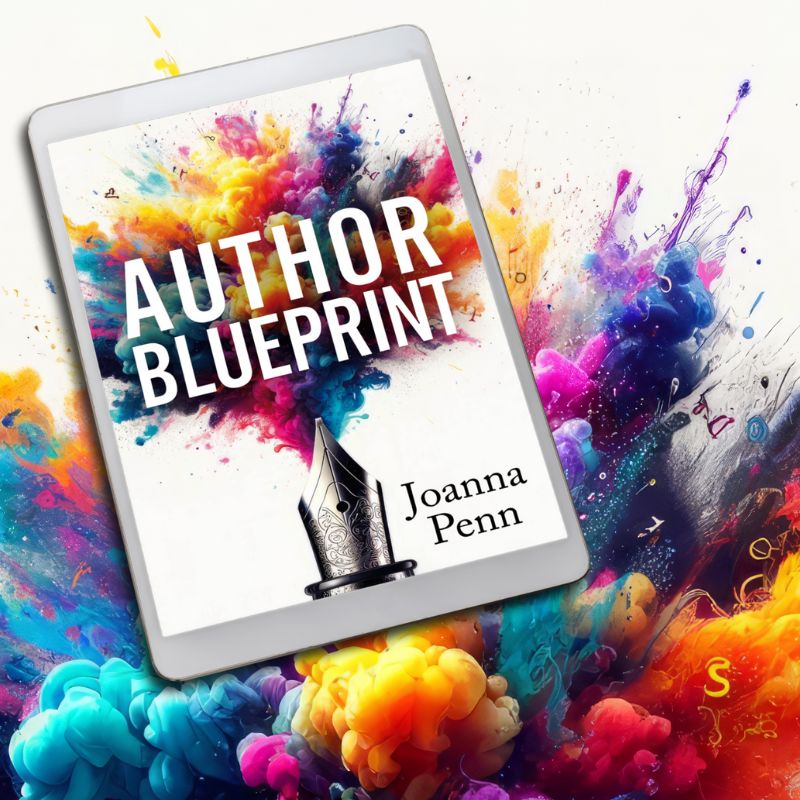
Thanks as always for an interesting report. I just wanted to say that I’ve also noticed a significant rise in sales in Germany–it has edged ahead of Australia to become my fourth biggest market this year. Most of those sales are on Amazon.de. For those who don’t know, my income is only from sales of fiction.
Thanks, Jane 🙂 I’ve included your comment in the podcast for Monday when I’ll be discussing this. Great to know that Germany is finally taking off. I was definitely way too early publishing there in 2014! Time to try again 🙂
“You don’t need to be a household name to make a decent living with your writing.”
For me, Joanna, that was the best sentence of this article. I love that you have the courage to post your business numbers for all to see; however, that one line should give budding authors encouragement. Heck, all authors for that matter. Everyone needs a shot of hope from time to time.
I’m coming up on four years in this industry, and I can add my “plus 1” to your claim. “You don’t need to be a household name to make a decent living with your writing.”
Hang in there, fellow authors. And regardless of the figures, keep…writing…more…books. The sales will follow.
Glad you agree 🙂
Thanks for sharing Joanna. You are such an empowering, positive inspiration. Congratulations on building a business you love
Thank you 🙂 I wouldn’t have believed this 10 years ago!
I appreciate your sharing the data to help us have a sense of what is (and what isn’t) working. I’m not surprised to hear that you intend to increase your ad spend moving forward. From what I’m reading/hearing from other indie authors, looks like we’re all in the same boat: Without ad spends, it’s getting increasingly difficult to have our books found by new readers.
Though the data is from 2018 as I do my year-end wrap up in December each year, my latest author earning report is on my website in the For Authors/ The Writing Life section (I’d post here, but can’t as seem to add links in a comment).
It’s a bit of a horror story as I’m not in the black. Discoverability and running affording ads continue to be the biggest challenge for me. The good news is that in 2019 I’ve found ways to cut expenses considerably on the production of new books.
For other new indie authors reading this post, I hope my numbers are a realistic snapshot of what is possible. Running an indie author business is extremely difficult!
Thanks, Ron, glad you found it interesting – and I do wonder if I would be in the black if I only wrote fiction. My non-fic brings in so many income streams, plus I’ve built this site and podcast, so the non-fiction eco-system is stronger. My aim is to build up a fiction eco-system in the same way.
I’m still making enough to pay for my bus tickets all year – as writing is by far not my main activity or source of income, I’m OK with that. But I’ve also noticed print sales have gone up, some months above ebooks!
Woohoo! Glad to hear things are good with you, Liz!
Thanks for posting this. Some interesting charts especially the reduction in your US income v concentrating on other global markets. Well done.
Thanks 🙂 I don’t actively pursue the other markets but by the mere fact of (a) distributing wide and (b) having global marketing efforts like this blog and podcast, people find my books from all over the world. Fun times!
Thank you for sharing your data with us!
As another commenter mentioned, your quote about not needing to be a household name to make a decent living really struck a chord with me. However, in my mind, you’re pretty darn famous. 🙂
Thank you, Joanna, for inspiring me to write non-fiction books. Do you think PublishDrive will take a bigger role in your revenue stream over the next years?
It is so nice that you break down all of this information for us. My first novel went to my editor last night so I am now going to try to edge into the business side of things. It is also refreshing for you to state that you are never going to write to market etc. I sometimes feel a lot of pressure to “Write what sells” “Write to market” “Have three finished novels before you release the first”. I just feel like I can’t. I want to enjoy the process and I think it will take the fun out of it and that is part of the point–to make a living AND enjoy doing it! I do not want it to start to feel like a chore or a burden. I don’t want to burn out like I am at my current job !!! Thanks again! Now I’m off to order some more of your books!
Inspiring! And fascinating, especially how much your country split has changed in just a year. Thanks for sharing this, Joanna.
Thanks for sharing, Joanna. Very inspiring, especially for me, that haven’t published my first book yet 😮
In some of your podcasts you have mentioned that book sales is a relatively small part of your business. I can understand that you might not want to share the totals…
All the best,
BW
I love these annual breakdown posts – always honest and inspiring.
This is wonderful of you to share and keeps me inspired. I started to follow this site back in 2011 or so and you’re the reason that I took the plunge in 2015. This is my first year where I finally have real steady sales thanks to FB ads. I too am wide, fiction only as it’s what I enjoy to write. My fifth book is going through final edits. Continued success, Joanna.
Thanks Francois, and all the best with the next book!
I notice you have a tiny slice of Publishdrive in your pie. Do you just have one or two books with them? I had gathered they take exclusivity on the books you place with them.
I only have one novel, so far, but I had to take it down from Amazon, Apple and Kobo before I could place it through PD. Is there a trick to this, or is it as I had assumed – you have one or two books exclusive with PD?
I have all my wide books with them, but because I go direct to the big stores (Amazon, Apple, Kobo) and also use D2D for Nook, I am really only selling at Google Play on PD so they don’t get much chance for my revenue 🙂 You can deselect the stores you don’t want to use on PD per book.
Hi Joanna, thanks for your (always) interesting annual update.
I noticed you sell wide, using D2D and Publishdrive. These are somewhat identical, comparable and competitive services. And as far as I can tell they distribute to the same stores / channels. Can you tell me why and how you use both? Are you selling the same titles through both channels? I wonder what happens if you publish and distribute the same books through multiple channels .
I use KDP for selling on Amazon; Smashwords for the other channels. As I also want my books on Google Play I published a few titles on XinXii (www.xinxii.com) back in december 2018, carefully selecting only those channels to which Smashwords doesn’t distribute.
As I uploaded Word-documents, XX had to create the epubs. Uptill now 3 out of 7 titles eventually popped up on Google Play. After 6 months (!) the other titles still are only available in PDF format. Some of them had over 300 views, but no sales. (Yeah, right. How comes if there’s only a PDF available…) These views are based on visitors to the XX-site (which can also be used for direct selling).
Last week I decided to try out 2 more titles, uploaded these directly as epubs; but unfortunately this doesn’t seem to speed up the proces. They are still in the process of ‘submission’. Available on the XX-site, but not yet distributed. As said I already distribute through others aggregators, so it’s not a big loss (yet…). On the other hand, as Jane Steen said in her comment, Germany seems to be a very promising and upcoming ebook market. As XX has its base in Germany I reckoned this aggregator would be highly interesting for distributing to Thalia and others. Love to hear some reactions from others selling through XX.
By the way. I am Dutch. The above is for the English editions of my books. For the moment KOBO seems to be the best channel to sell Dutch books (Rakuten / KOBO which includes bol.com). There are some fine POD companies overhere which also offer ebook distribution however I consider the margins / revenues they offer to be far too low.
Greetings from below sea level!
Thanks for your comments 🙂 As I’ve been doing this a long time, I have joined services as they emerged. I joined D2D when it became available and use it for Nook and some other smaller distributors. When PD arrived, I joined that for Google Play. I have never used Xinxii so can’t comment on that. You can use D2D or PD for Tolino.
Very interesting, Joanna, thanks for the charts. (I was one of the folk organising the SoAiS conference a couple of years ago, so heard you speak there.) I only write fiction – and not fast! as the books are a) historical, set in real history and therefore requiring lots of research, and b) long – between 100k and 132k. I am hybrid with the ebooks of one of my series with a mainstream publisher, but I have all the print rights and another set with all rights. (When my next book is out in a couple of weeks I will have 5 novels and 1 collection of short stories. ) I’ve concentrated on selling print and have chosen to do trad runs of mostly 500 copies at a time – which makes the unit cost very reasonable and they are with a distributor in London so available to bookshops. I released my first Indie published book in Autumn 2015 and am pleased to say I am well in the black with about equal sales in e and print books, but with a much bigger proportion of income from the print, especially when I sell directly at speaking events or craft fairs. I totally agree with you that fiction has to be a long term game , but it is possible to steadily build up an income by thinking a little bit outside the box re outlets for print books. One of my best outlets is actually a café – in the middle of nowhere, but on a tourist route – which suits the content of my books. I am currently learning about advertising with a view to ploughing some money back into that and looking ahead to becoming more business-focused. Your podcasts are really useful to watch.
Thanks, Margaret. I love this 🙂
“it is possible to steadily build up an income by thinking a little bit outside the box re outlets for print books. One of my best outlets is actually a café – in the middle of nowhere, but on a tourist route – which suits the content of my books.”
“I will never be a high-volume writer in one targeted genre. I will never write to market. I will never be an expert in paid ads.”
AMEN!!!!!
I don’t write a billion books a year, I don’t write what’s popular, and I still don’t fully grasp paid ads. But I am going to follow your lead and start turning my knowledge into non-fiction that dovetails with the types of fiction genres I write in. Here’s to 2020!!!
(sorry for 3000 exclamation marks)
I think you’ll do great with non-fiction 🙂 Glad you’re excited too!!!!!!!!
Thanks for sharing this data, Joanna. It’s fascinating. I’ve been looking at my own data – only 4 nonfiction books, so paltry compared to your catalog. Despite focusing on going wide in all formats (ebook, print and audio), I’m still close to 80/20, with 80% of revenues from Amazon properties and 20% from everything else (not counting international translation rights.) You’ve inspired me to slice and dice the data different ways, though.